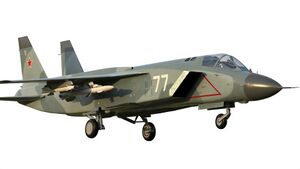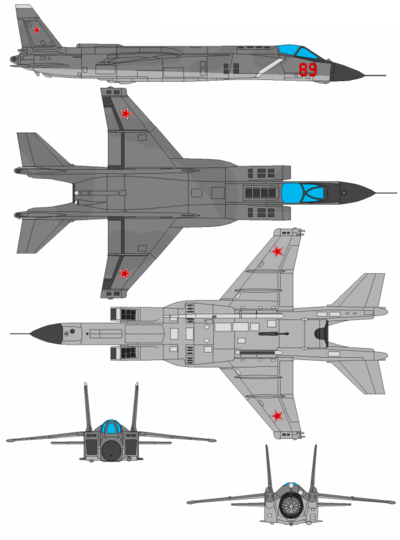Tlo-35
| Tlo-35 Skua | |
|---|---|

| |
| Role | Fighter |
| Manufacturer | Cuauhquetztia |
| Designer | NTT 144 |
| First flight | 1984 |
| Introduction | 1985 |
| Status | In service |
| Primary user | |
| Produced | 367 |
| Developed from | Tlo-26 |
The Tlo-35 Skua is a supersonic vertical takeoff and landing fleet defense fighter aircraft in service with the Naval Aviation Corps of the Zacapine Navy. It was designed by the renowned NTT-144 design unit at the behest of the Admiralty. While it was being produced, the Tlo-35s were built at the Cuauhquetztia aircraft plant in Tecolotlan in the Zacaco Republic, Zacapican. It is slated to be replaced by the Tlo-55 next generation fighter currently under development. As with other Zacapine VTOL aircraft such as the Tlo-26 or the Itz-31, the primary function of the Tlo-35 is to preform a variety of missions launched from aircraft carriers of the Zacapine Navy, particularly the smaller Mizyaotl and Cuitzeo class carriers which are incapable of launching non-VTOL/STOVL aircraft such as the larger and more modern Tlo-45. Together with the Tlo-45, the Tlo-35 forms the core of Zacapine carrier aviation and by extension is an important component of Zacapine naval power.
Development
The advent of jet aircraft in the 1940s and 50s left the Zacapine Navy with a developing problem of a technical nature. The newer and more powerful jet fighters and bomber aircraft of the era required much longer runways to take off and land compared to their propeller-driven antecedents, pushing the Navy to develop larger and larger aircraft carriers in order in order to continue to field the newest and most capable combat aircraft. However, these ships were large and expensive and could not be pushed into service across the wide variety of roles that the smaller, more numerous aircraft carriers of earlier years had been. Smaller classes of carrier were drafted up to serve as escorts and auxiliaries for the Navy's carrier groups, but these could only operate rotary-wing aircraft which lacked the range and speed of jet aircraft. The Navy desperately needed a jet fighter aircraft capable of being launched and recovered from the decks of these light helicopter carriers, and so the NTT design units were put to the task. NTT 144 alone had two different design teams working on three models of STOVL and VTOL jet fighters, and would eventually produce the Tlo-26 VTOL naval fighter which first flew in 1971.
Design
Specifications
General characteristics
- Crew: 1
- Length: 18 m (59 ft 1 in)
- Wingspan: 10.105 m (33 ft 2 in)
- Height: 5 m (16 ft 5 in)
- Wing area: 31 m2 (330 sq ft)
- Empty weight: 11,500 kg (25,353 lb)
- Max takeoff weight: 20,000 kg (44,092 lb)
- Powerplant: 1 × Nececetililiztli N-300 afterburning vectoring-nozzle turbofan, 110 kN (25,000 lbf) thrust dry, 155 kN (35,000 lbf) with afterburner
- Powerplant: 2 × AT-20 turbojets, 42 kN (9,400 lbf) thrust each canted rearwards from vertical
Performance
- Maximum speed: 1,800 km/h (1,118 mph; 972 kn)
- Range: 2,100 km (1,305 mi; 1,134 nmi)
- Ferry range: 3,000 km (1,864 mi; 1,620 nmi)
- Service ceiling: 15,500 m (50,900 ft)
- Rate of climb: 250 m/s (49,000 ft/min)
Armament
- Guns: 1 × 30 mm cannon with 120 rounds
- Hardpoints: 4 underwing and 1 fuselage hardpoints with a capacity of 2,600 kg (5,733 lb) of external stores,with provisions to carry combinations of:
- Missiles: T-77 air-to-air missiles, T-73 AAMs, T-37 AAMs, and TlaT air-launched cruise missiles
